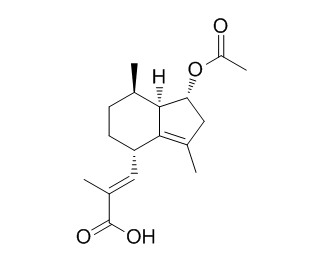Acetoxyvalerenic acid
Acetoxyvalerenic acid may have anxiolytic activity.
Inquire / Order:
manager@chemfaces.com
Technical Inquiries:
service@chemfaces.com
Tel:
+86-27-84237783
Fax:
+86-27-84254680
Address:
1 Building, No. 83, CheCheng Rd., Wuhan Economic and Technological Development Zone, Wuhan, Hubei 430056, PRC
Providing storage is as stated on the product vial and the vial is kept tightly sealed, the product can be stored for up to
24 months(2-8C).
Wherever possible, you should prepare and use solutions on the same day. However, if you need to make up stock solutions in advance, we recommend that you store the solution as aliquots in tightly sealed vials at -20C. Generally, these will be useable for up to two weeks. Before use, and prior to opening the vial we recommend that you allow your product to equilibrate to room temperature for at least 1 hour.
Need more advice on solubility, usage and handling? Please email to: service@chemfaces.com
The packaging of the product may have turned upside down during transportation, resulting in the natural compounds adhering to the neck or cap of the vial. take the vial out of its packaging and gently shake to let the compounds fall to the bottom of the vial. for liquid products, centrifuge at 200-500 RPM to gather the liquid at the bottom of the vial. try to avoid loss or contamination during handling.
Int J Mol Sci.2024, 25(5):2799.
Food Funct.2020, 11(2):1322-1333.
Plant Science2024, 338:111914
Progress In Microbes & Molecular Biology2025, 8,1:a0000470.
Cells. 2023, 12(15):1934.
Front Plant Sci.2020, 11:630.
South African Journal of Botany2024, 168:209-220.
J Nat Prod.2021, 84(9):2544-2553.
Plants (Basel).2021, 10(11):2317.
Front Microbiol.2023, 14:921653.
Related and Featured Products
Phytomedicine, 2012, 19(13):1216-1222.
Valerian extract characterized by high valerenic acid and low acetoxy valerenic acid contents demonstrates anxiolytic activity.[Reference:
WebLink]
Valerian is one of the most commonly used herbal remedies for the treatment of insomnia and anxiety. Valerian extracts allosterically modulate GABAA receptors, an action related to valerenic acid, which is one of the active compounds determined from pharmacological studies. Derivatives of valerenic acid, i.e. Acetoxyvalerenic acid or hydroxy valerenic acid, do not allosterically modulate GABAA receptors, but they bind to identical binding sites. Therefore, the question arises whether they might interfere with the effects of valerenic acid.
METHODS AND RESULTS:
Two valerian extracts were tested in the elevated plus maze test and the tail suspension test for anxiolytic and antidepressive activity, respectively. Reference substances were diazepam (1.0 mg/kg) and imipramine (30 mg/kg). The extracts were standardized to the identical total amounts of the acids (0.1; 0.5; 1.0 and 2.0 mg/kg), i.e. valerenic and Acetoxyvalerenic acid, but the ratio between the acids was different (12:1 and 1:1.5). The extract with the ratio 12:1 prolonged the time spent on the open arm significantly when 0.5 mg/kg was applied. Of the other extract, with the ratio 1:1.5, four times that amount was required (2.0 mg/kg). Both of the tested extracts did not show any antidepressive effect, rather the other way around, the extract with the ratio 1:1.5 prolonged the immobility phase. However, since the core body temperature was reduced by the 1.0 and 2.0 mg/kg extract dose, the prolongation may be related to the temperature phenomenon and is not indicative of a specific depressive action.
CONCLUSIONS:
In conclusion, the anxiolytic activity of the valerian extract seems rather related to valerenic acid and, moreover, standardization with respect to the total amount of valerenic acids, i.e. valerenic acid together with acetoxy valerenic acid, is misleading.
Die pharmazie, 2004, 59(9):727-8.
Extraction of valerenic acids from valerian (Valeriana officinalis L.) rhizomes.[Reference:
WebLink]
Extraction of valerenic acids (valerenic, acetoxyvalerenic and hydroxyvalerenic) from dry ground rhizomes of valerian (Valeriana officinalis L.) was studied.
METHODS AND RESULTS:
The effect of ethanol concentration in the solvent, extraction temperature and drug particle size on extraction kinetics were investigated and the optimum values of these process parameters were determined for the case of intensively stirred two-phase dispersion.
CONCLUSIONS:
It was found that increased processing temperature favors extraction kinetics, but provokes moderate degradation of valerenic acids.



